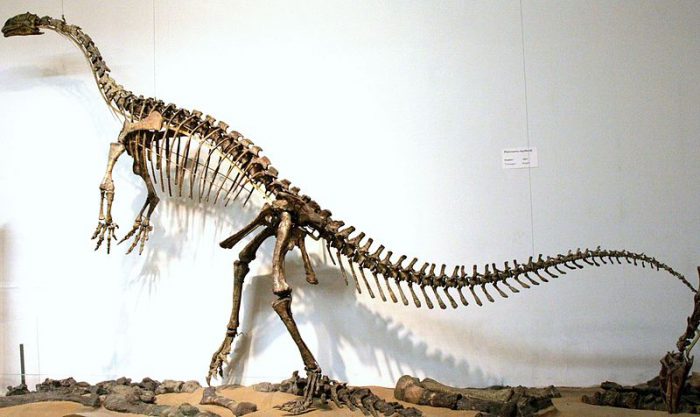A new fossil discovered in Argentina is turning the dinosaur world upside down. With its large body, thick legs, long neck and tail, and tiny head, this plant-eating dinosaur species looks a lot like other plant-eating dinosaurs you might imagine.
But at somewhere between 237 to 201 million years old, this dinosaur lived during the Triassic period, which makes it way old for a larger dino. In fact, its name is Ingentia prima, meaning "first to be huge", which leads to the obvious question.
Was it?
As in, was it really the first huge dinosaur? Because if it was, that just might make it the first sauropod.
Life of the long necks
A Diplodocus skeleton. It was one of the longest dinosaurs ever known. (Getty Embed)
Sauropods were a branch of dinosaurs that represented the largest land animals ever discovered. You know, the long necks! They were quadrupeds, meaning they used all four legs to support their massive bulk. They are also some of the most well-known dinosaurs species ever, including Brachiosaurus, Apatosaurus, Diplodocus, and Argentinosaurus.
Now, sauropods as we best know them, first made their appearance in the Jurassic period (199 to 145 million years ago). This is when gigantism in dinosaurs really kicked in, creating enormous land animals that were several times heavier and bigger than not only the largest land animals today (such as elephants), but also the reptiles in the Triassic period. But while scientists know a lot about these Jurassic beasts, what is a little less clear is who their ancestors were.
Where did sauropods come from?
Is that you, Great Great Great Great Grandpa?

Plateosaurus was an ancestor of Jurassic sauropods. (Wikimedia Commons/FunkMonk)
Currently, there is a small category of dinosaurs called basal sauropodomorphs, or prosauropods. Not helping? Basically it just means "sauropod ancestor". The Triassic dinosaur Plateosaurus is one of them.
Prosauropods were smaller than sauropods. For example, Plateosaurus was about 8 metres (26 feet) versus the 22-metre (72-foot) Apatosaurus. They were also bipedal, or two-legged walkers, instead of quadrupeds. But scientists believe that sauropods began with animals like Plateosaurus.
Which brings us back to our new (old) friend, Ingentia prima. At about 10 metres (32 feet), it was heavier and longer than a Plateosaurus. It may have lived even earlier. It also appears to have been a quadruped, too. So was Ingentia a prosauropod ... or was it the earliest true sauropod that ever lived?
Lots left to learn
That's probably the biggest debate that paleontologists need to have about this fascinating fossil. An animal with Ingentia's body type could have easily walked on two legs, not four. And while nearly all dinosaur fossils are incomplete, it doesn't help that in this case, the hip and thigh bones are some of the missing pieces.
Only more analysis—and hopefully the discovery of other, more complete Ingentia prima fossils—can make the answer clearer. Sauropod or not though, it seems clear than we're staring at a moment when dinosaurs started going from being reptiles the size of a large dog to becoming beasts that would dwarf all life around them.
 First sauropod or just a distant cousin? The discovery of Ingentia prima is giving dino experts a lot to chew on. (Jorge A. González)
First sauropod or just a distant cousin? The discovery of Ingentia prima is giving dino experts a lot to chew on. (Jorge A. González)










NOOOOO